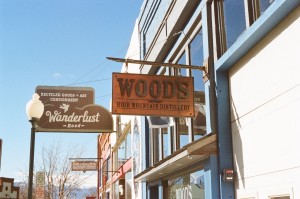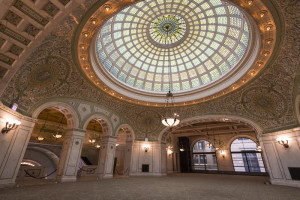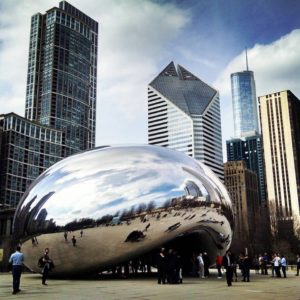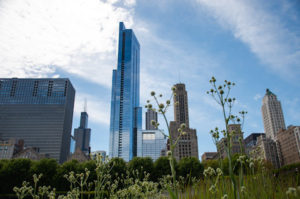Introduction
Welcome to Chicago’s infamous gangster history! This self-guided walking tour will take you through approximately one mile of the Windy City’s most notorious neighborhoods, revealing the dark and fascinating criminal past that helped shape Chicago’s identity. The tour focuses primarily on the North Side and Loop areas where much of the city’s gangland activity took place during the Prohibition era and beyond.
Tour Length: Approximately 1.8 miles
Duration: 90-120 minutes
Start Point: Old Water Tower/Jane Byrne Plaza (Michigan and Chicago Ave)
End Point: Federal Plaza (Jackson and Dearborn St)
Google Maps: Crime & Gangster Tour Route
Prefer to join a guided tour? Check out our schedule and book your Crime and Gangster tour online: Chicago Crime & Gangster Tour
Stop 1: Old Water Tower/Jane Byrne Plaza
Location: Michigan Avenue and Chicago Avenue
Begin your tour at Chicago’s historic Old Water Tower, one of the few structures to survive the Great Chicago Fire of 1871. This limestone tower, built in 1869, originally held a huge pipe containing Lake Michigan water for firefighting. When the Great Fire destroyed most of the city, this tower remained standing and became a symbol of Chicago’s resilience.
This neighborhood was once the territory of Dean O’Banion, an important figure in Chicago’s criminal history. Born in 1892, O’Banion grew up in a dangerous neighborhood called Little Hell and ran with the Market Street Gang. Initially a safecracker and burglar, O’Banion eventually controlled the bootlegging operations in Chicago’s North Side during Prohibition, which began in January 1920 when the National Prohibition Act (Volstead Act) became law.
O’Banion and his North Side Gang competed with Johnny Torrio and Al Capone’s South Side operation, creating tensions that would eventually erupt into the deadly “Beer Wars.”
Walking Directions to Stop 2: Head west on Chicago Avenue, then turn south onto State Street. Walk to 730 N. Wabash Ave.
Stop 2: Holy Name Cathedral
Location: 730 N. Wabash Ave (stop on State Street side)
Holy Name Cathedral, dedicated in 1875, is not only a beautiful church but also a site with deep connections to Chicago’s gangland history. Across the street once stood Schofield’s Flower Shop, where Dean O’Banion worked as part owner. The flower shop provided O’Banion with a legitimate business front for his bootlegging operations.
Despite his reputation as a ruthless killer (allegedly responsible for about 25 deaths), O’Banion was known for his friendly demeanor and always wore a flower in his lapel. His bootlegging empire was incredibly lucrative, particularly in this wealthy area of the city.
In 1924, relations between O’Banion’s North Side Gang and Torrio/Capone’s South Side operation deteriorated rapidly. After several disputes, including O’Banion’s sabotage of Sieben’s Brewery that cost Torrio approximately $7 million in today’s money, Torrio ordered a hit on O’Banion.
On November 10, 1924, three men entered Schofield’s Flower Shop. One offered his hand to O’Banion in what locals call a “Chicago Handshake” – grabbing and holding O’Banion’s right hand so he couldn’t reach for his gun. O’Banion was shot twice in the chest, twice in the throat, and once in the head. His funeral featured an astounding 26 truckloads of flowers.
After O’Banion’s death, Hymie Weiss took over the North Side Gang. Known for his intense, scary presence, Weiss was reportedly the only man Al Capone feared. On October 11, 1926, Weiss and his entourage were crossing the street near the cathedral when gunmen raked them with Thompson submachine gun fire from a second-floor apartment. Weiss took 10 bullets and died that day. Some stray rounds struck the church, and locals claim that one bullet hole can still be seen in the cornerstone.
Walking Directions to Stop 3: Continue south on State Street to East Ontario Street, then turn east. Walk to 55 E. Ontario St.
Stop 3: 21c Museum Hotel (formerly James Hotel)
Location: 55 E. Ontario St.
The James Hotel, formerly the Hotel McCormick, plays a significant role in Chicago gangster lore. This location is associated with “Machine Gun” Jack McGurn, one of Al Capone’s most trusted killers.
Born as Vincenzo Antonio Gibaldi in Sicily in 1902, McGurn immigrated to America at age 4 and eventually settled on Chicago’s West Side. A talented boxer who changed his name to sound more Irish (as Irish boxers were considered the toughest), McGurn caught the attention of the Capone organization after killing those responsible for his stepfather’s murder.
On March 7, 1928, McGurn and real estate man Nick Mastro were in the Hotel McCormick’s tobacco shop when members of the North Side Gang, who controlled this territory, decided to send McGurn a message. Two men burst into the shop with a pistol and a Thompson submachine gun. McGurn was wounded in the chest and arm but managed to escape to his room, where a hotel doctor treated him before he was taken to the hospital.
McGurn survived but refused to identify his attackers to police, saying he would “take care of it himself.” Witnesses identified the gunmen as Frank and Peter Gusenberg, hitmen from the North Side Gang. Both Gusenberg brothers were later killed in the infamous St. Valentine’s Day Massacre of 1929, which many believe McGurn helped orchestrate for Capone. McGurn himself was eventually murdered in a bowling alley on Milwaukee Avenue in 1936.
Walking Directions to Stop 4: Walk west back to State Street, then south to the corner of Grand Avenue and State Street.
Stop 4: Grand and State (Juice Loan Corner)
Location: Southeast corner of Grand Avenue and State Street
After Prohibition ended in 1933, Chicago mobsters diversified their criminal enterprises. One lucrative business was “juice loans” – illegal, high-interest loans that were common until a few decades ago. When banks were less accessible and credit cards weren’t widespread, the Chicago Outfit provided quick cash with no questions asked – but at an enormous price, with interest rates reaching 20% per week.
This intersection was where Frank and Nick Calabrese, two brothers from Chicago’s West Side, sold newspapers as children. As adults, they became top juice-loan racketeers for the Chicago Outfit, making millions for their bosses. This trust led them to become mob enforcers involved in at least 14 Outfit murders between 1970 and 1986.
The Calabrese brothers’ story took a dramatic turn decades later. While serving prison terms for loan-sharking, Frank Jr. (Frank’s son) approached the FBI wanting to keep his father locked up forever. Frank Jr. wore a wire to record his father discussing crimes, and Nick Calabrese eventually cooperated with the FBI in their investigation of old Outfit murders. This led to “Operation Family Secrets,” a landmark trial in 2007 that resulted in life sentences for several mobsters, including Frank Calabrese Sr., who died in prison on Christmas Day 2012. Nick Calabrese received a reduced sentence for his cooperation and entered witness protection upon release in 2013.
Walking Directions to Stop 5: Continue south on State Street to Wacker Drive. Turn west and stop in front of Marina Towers.
Stop 5: Marina Towers
Location: 290 N. State St (north side of Wacker Drive)
The distinctive Marina City towers, built in 1964, housed a fascinating character in Chicago organized crime history – Murray Humphreys, known as “The Camel.” Born to Welsh immigrants, Humphreys was a non-Italian associate of Al Capone who became a crucial part of the Chicago Outfit.
Humphreys started as a restaurant cook who was caught hijacking Capone’s bootleg liquor. Rather than punishing him, Capone was impressed and gave him a job. Humphreys eventually became the Outfit’s financial advisor, handling money transfers to politicians and other officials.
At the end of his life, Humphreys lived on the 51st floor of the east Marina City tower. The FBI had hidden microphones in his apartment to monitor conversations. In November 1965, FBI agents came to arrest him for dodging a subpoena. They had to wrestle the aging Humphreys to handcuff him. Although they didn’t lock him up that night, Humphreys was found dead of a heart attack hours later, likely from the stress of the confrontation.
Many believe that Murray Humphreys was the inspiration for the character Tom Hagen (played by Robert Duvall) in “The Godfather.”
Walking Directions to Stop 6: Continue west on Wacker Drive to the Clark Street Bridge.
Stop 6: Clark Street Bridge
Location: Clark Street Bridge over Chicago River
Built in 1929, the Clark Street Bridge offers excellent views of the Chicago River and downtown. It’s also connected to Vincent “Schemer” Drucci, who took over the North Side bootlegging gang after Hymie Weiss was killed in 1926.
Born in Chicago to Sicilian parents in 1898, Drucci served in the U.S. Navy during World War I before turning to crime. He got his nickname “The Schemer” from his wild ideas, like overthrowing the government to become president or stealing England’s crown jewels. Despite his prankster reputation (he once dressed as a priest to make inappropriate comments to passersby), Drucci had a violent temper that earned him enemies.
On April 4, 1927, police arrested Drucci for attempting to ransack a political opponent’s office during a mayoral election. While being transported from the police station to the Criminal Courts building, Drucci began threatening Sergeant Dan Healy, the arresting officer. When Drucci lunged at Healy and tried to grab his gun, Healy shot Drucci in the arm, leg, and abdomen. Drucci died later that day, becoming the only Chicago mob leader killed by law enforcement.
Some believe Drucci’s unpredictable and manic personality inspired the character of the Joker in Batman comics.
Walking Directions to Stop 7: Continue south on Clark Street, then turn east on Adams Street. Walk to Dearborn Street and turn south. Continue to Federal Plaza at Jackson and Dearborn.
Stop 7: Federal Plaza
Location: Jackson and Dearborn Street
Your final stop is Federal Plaza, home to the Kluczynski Federal Building, Post Office, and Dirksen United States Courthouse. This site represents law and order in Chicago’s gangland saga.
Before this complex was built, this was the location of the old Chicago Federal Building until 1965. The building hosted Al Capone’s famous 1931 tax evasion trial that resulted in his 11-year prison sentence. Though Capone had evaded prosecution for bootlegging and murder, the IRS eventually built a case against him for tax evasion following a 1927 Supreme Court ruling that illegally earned income was still taxable. Capone served time in Atlanta Federal Penitentiary and later Alcatraz before being released in 1939 due to declining health. He died in 1947 from complications of syphilis.
The modern Dirksen United States Courthouse hosted the landmark “Operation Family Secrets” trial in 2007, which dealt a significant blow to the Chicago Outfit. The case began when Frank Calabrese Jr. and his uncle Nick Calabrese (whom you learned about at Stop 4) cooperated with the FBI. The trial resulted in convictions for 18 gangland murders and life sentences for major Outfit figures, including Frank Calabrese Sr.
This operation marked the first time an official member of the Chicago Outfit (Nick Calabrese) testified against his former associates. While the trial significantly disrupted the Outfit’s operations, it didn’t eliminate the organization entirely. Both Frank Calabrese Jr. and Nick Calabrese still cannot return to Chicago for fear of retribution.
Conclusion
Congratulations on completing the Chicago Crime & Gangster Self-Guided Walking Tour! You’ve walked in the footsteps of some of America’s most notorious criminals and witnessed firsthand the locations where Chicago’s dark history unfolded.
If you enjoyed this self-guided experience and want to learn even more about Chicago’s fascinating criminal past, consider joining our expert-guided Chicago Crime and Gangster Tour. Our knowledgeable guides provide additional stories, insights, and historical context that bring these locations to life in even greater detail.
For more information or to book a guided tour, visit Free Chicago Walking Tours.
Map of Tour Route
Google Maps: Crime & Gangster Tour Route
Start Point: Old Water Tower/Jane Byrne Plaza (Michigan and Chicago Ave)
End Point: Federal Plaza (Jackson and Dearborn St)
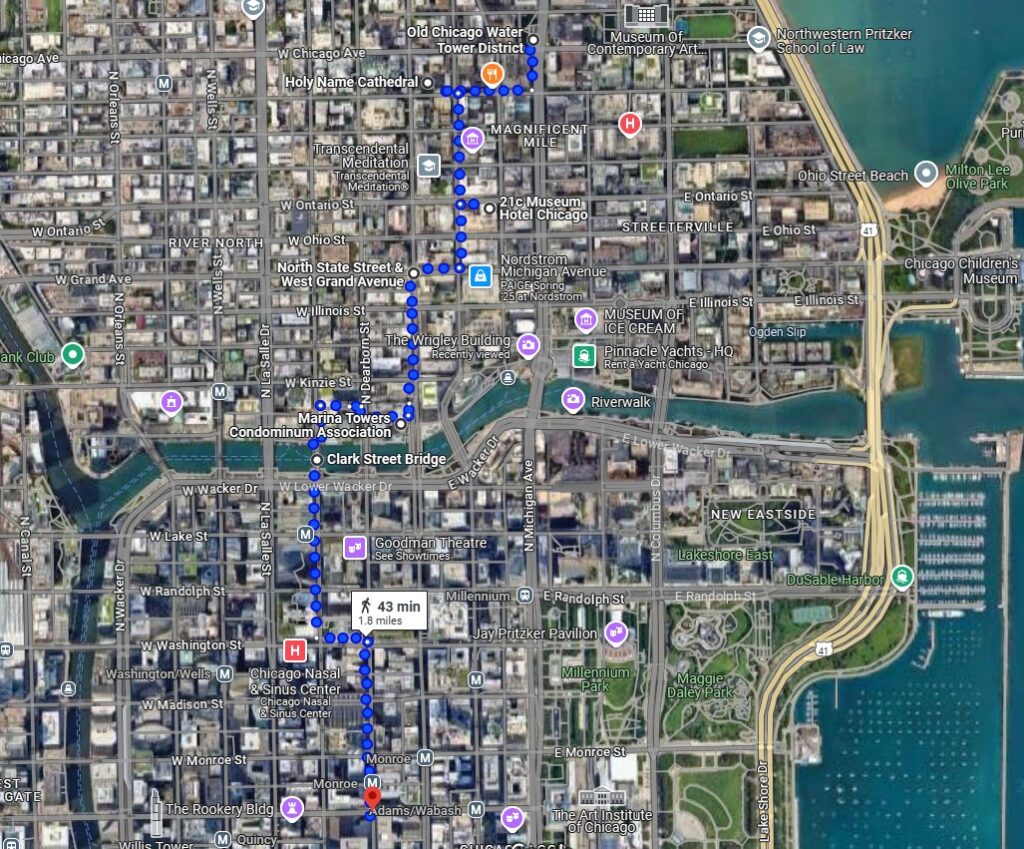
Note: This self-guided tour is designed for informational and educational purposes only. Please be aware of your surroundings at all times and respect private property. Some historical sites may be located in busy areas; please use crosswalks and follow traffic signals for your safety.


